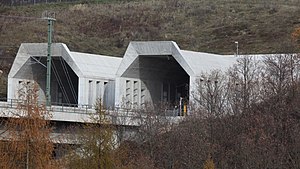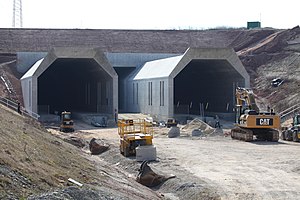Bibra tunnel
| Bibra tunnel | ||
|---|---|---|
|
East portal of the Bibra tunnel (March 2012)
|
||
| use | Railway tunnel | |
| traffic connection | New Erfurt – Leipzig / Halle line | |
| place | Hermundurian plaice | |
| length | 6467 m | |
| Number of tubes | 2 | |
| Largest coverage | 50 m | |
| construction | ||
| start of building | October 17, 2008 | |
| completion | 2012 | |
| map | ||
 West portal of the Bibra tunnel
|
||
| location | ||
|
|
||
| Coordinates | ||
| West portal | 51 ° 12 ′ 35 " N , 11 ° 33 ′ 17" E | |
| East portal | 51 ° 15 ′ 25 " N , 11 ° 36 ′ 18" E | |
The Bibra tunnel is a railway tunnel on the new Erfurt – Leipzig / Halle line . At a length of 6467 m each, its two tunnels cross under the Hermundurian Plaice plateau in a north-easterly direction and come to the surface again west of the Unstrut Valley . The west portal is between Bad Bibra and Saubach .
The shell work on the 230 million euro tunnel was completed in 2012.
course
The tunnel is between the route kilometers 237,301 and 243,768. It consists of two parallel, single-track tunnels with a center distance of 20 m to 25 m. The two tubes run from southwest to northeast. In the first kilometer, the gradient rises with 2.5 per mille, and then drops down to the east portal with 4 per mille. The overlap is between 15 m and 50 m. The federal highway 250 is driven under north of Bad Bibra.
The west portal is joined by the Saubachtal bridge , the Saubachtal overtaking station and the Finne tunnel . The east portal is followed by a section of ground level with the Nebra transfer point and the Unstruttal bridge .
geology
Geologically , the entire length of the tunnel in layers of the Middle Buntsandstein is consistently around 30 m above the water table.
history
planning
In 1994 a length of 6800 m was planned for the structure. The building was calculated at 310 million Deutschmarks net, the technical equipment at 40 million DM.
The structure is in the planning approval section 2.2 of the new line.
According to the planning status from mid-1995, the structure, with a length of 6414 m, should be between the construction kilometers 46.22 and 52.63.
As part of a plan change procedure, the number of cross passages was increased from six to 13 in 2009 and the tunnel portals were supplemented by sonic boom structures to prevent the tunnel bang .
construction
The construction contract for the tunnel, including the earthworks at around 1300 m, followed by the open road was in Europe in August 2007, tendered and awarded in January of 2008.
Construction work began in May 2008 with the excavation of pre-cuts on both portals. As preparatory measures, the 60,000 m² site facility and a starting pit were built. In addition, 10 km long construction roads were built .
The tunnel was officially opened on October 17, 2008. The tunnel sponsorships were taken over by the Saxony-Anhalt Minister of Health and Social Affairs, Gerlinde Kuppe and Gisela Reiche, the wife of District Administrator Harri Reiche . Symbolically, the two triggered the first two explosions. The drive ran simultaneously in both tubes in both directions.
The tunnel was excavated using conventional shotcrete methods . The two tubes were built in parallel, starting from both portals, partly with blasting and partly with extraction tools. With a diameter of 9.6 m each, the excavated cross-section is approx. 86 m². A total of 150,000 m³ of concrete and around 17,000 t of reinforcing steel should be used. The planned construction time was 21 months. A total of around 1500 tons of explosives had been calculated for the work. The completion should originally take place by December 31, 2011. Around 200 people were employed on the construction site during the construction work. In January 2009, a worker was killed in an accident at work.
The excavated volume of approx. 1.1 million m³ was used to change the terrain at the east portal. The excess mass was transported on a conveyor belt with a stacker . 13 cross-passages connect the two tubes with each other at a distance of 500 m.
The construction phase was preceded by an archaeological exploration program. In doing so, u. a. historical ramparts and moats from the Bronze and Iron Ages discovered. In addition, almost 5,000-year-old tombs were found. The construction work was accompanied by large-scale excavations by the State Office for Monument Protection and Archeology, which secures finds that are up to around 5,000 years old.
In addition to the tunnel, the tubes u. a. also an incision and an overpass in front of the east portal. A joint venture between Marti Tunnelbau AG , Marti Deutschland GmbH and Johann Bunte Bauunternehmung GmbH & Co. KG (Papenburg) was commissioned.
Breakthrough
Federal Transport Minister Peter Ramsauer , State Transport Minister Karl-Heinz Daehre and Railway Chief Rüdiger Grube carried out the breakthrough in the north tube by detonating it . In addition to the symbolic breakthrough of the neighboring Finne Tunnel on the same day, this marked the official “half-time” in the construction of the new Erfurt – Halle / Leipzig line. The breakthrough occurred in the north tube about 3.6 km from the west portal. Under the eyes of employees and the press, the guests of honor triggered the last demolition under the protection of the sixth cross passage (around 3.5 km from the west portal). Afterwards, guests of honor and the press drove to the east portal of the Finne Tunnel, in front of which the cutting wheel of the tunnel boring machine was ceremoniously unveiled.
business
Due to a one-day GSM-R fault in the tunnel, which meant that ETCS did not work, trains had to be diverted over the existing lines on June 27 and 28, 2017.
technology
The tunnel has a slab track and a Re 330 overhead contact line . The design speed is 300 km / h.
The tunnel will be equipped with digital BOS radio .
literature
- Holger Hagen, Reinhold Maidl, Dieter Handke: Analysis of driving experience with the Bibra and Finne tunnels . In: BauPortal, No. 12, 2012, pp. 18–22.
Web links
- Bibra tunnel. In: Structurae
- Tender documents and announcement of the award in the electronic gazette of the European Union
- Pictures of the construction site on bastellen-doku.info
- Flyer ( Memento from June 26, 2011 in the Internet Archive ) (PDF; 2.6 MB) on vde8.de
Individual evidence
- ↑ a b c d e f g h i j DB ProjektBau GmbH, regional area southeast, major project VDE 8, NBS Erfurt – Leipzig / Halle (publisher): New Erfurt – Leipzig / Halle line. Bibra tunnel . Brochure (6 pages) as of August 2008
- ↑ Bärbel Jossunek, Vasco P. Kolmorgen, Alexander Wolf: route brochure New Erfurt - Leipzig / Halle. (PDF) (No longer available online.) In: DB Netz; Infrastructure & technology; Customer information. Railway concept, August 13, 2015, archived from the original on August 16, 2015 ; accessed on December 29, 2015 .
- ^ Thomas Schubert, Frank Kniestedt: First course set: new railway line Erfurt-Leipzig / Halle . In: Baukultur , Heft 3, 1994, pp. 20-24, ISSN 0722-3099 .
- ^ Planungsgesellschaft Bahnbau Deutsche Einheit (Ed.): Transport project German Unity Rail No. 8: ABS / NBS Nürnberg-Erfurt-HalleLeipzigBerlin: Section Erfurt - Leipzig / Halle: Planning status June 1994 . Brochure, Leipzig, 1994.
- ^ Planungsgesellschaft Bahnbau Deutsche Einheit , Projektzentrum Leipzig (Ed.): Transport project German Unity - Rail No. 8: ABS / NBS Nuremberg - Erfurt - Halle / Leipzig - Berlin: Section Erfurt - Leipzig / Halle: Figures and facts . 20-page brochure, Leipzig, August 1995, p. 8 f ( PDF file , 2.73 MB).
- ↑ a b c Deutsche Bahn AG: Tunnel stop for 6.5 kilometer long Bibra tunnel on the new Erfurt – Leipzig / Halle line in the Burgenland district . Press release from October 17, 2008
- ↑ a b Start of construction for the 6.5 kilometer long Bibra tunnel . In: Mitteldeutsche Zeitung , October 17, 2008
- ↑ Control pressure leads to fewer accidents at work . In: Mitteldeutsche Zeitung , March 17, 2009
- ↑ a b 25 tunnels for the new and upgraded Nuremberg - Berlin line . In: Deine Bahn , ISSN 0948-7263 , pp. 14-18
- ^ Deutsche Bahn AG: Double tunnel breakthrough in Germany's largest infrastructure project Nuremberg-Erfurt-Halle / Leipzig-Berlin . Press release from March 3, 2010
- ↑ Digital train radio failed . In: Thuringian General . June 28, 2017, p. 5 .
- ^ D-Leipzig: Construction work for railway lines . Document 2012 / S 164-272946 of August 28, 2012 in the supplement to the Electronic Official Journal of the European Union .






